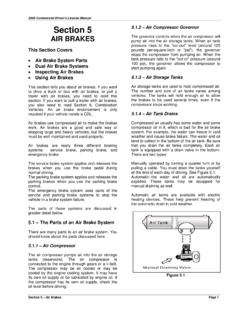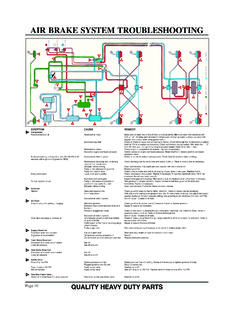Transcription of Air Brake and Train Handling Rules - rgpcops.net
1 For business purposes only. Unauthorized access, use, distribution, or modification of Union Pacific computer systems or theircontent is prohibited by Pacific RulesAir Brake and Train Handling RulesEffective January 20, 2012 Includes Updates as of July 2, 2013PB-20329 Union Pacific Railroad. All Rights Rules become effective at 0001, Friday, January 20, 2012. At that time, all previous Rules and instructions that areinconsistent with these Rules become : Train Air Brake Tests/Inspections Chapter : Locomotive Requirements Chapter : Securement/ Train Operations - Chapter : Distributed Power and Manned Helper Chapter : Train Handling Chapter : Remote Control Operations Chapter : Positive Train Control Chapter : Reserved for Future Use - Chapter : Commuter/Business Train Operations - Chapter : Equipment Charts/Diagrams - Brakes - Chapter 39 GLOSSARY: Glossary Union Pacific Rules Air Brake and Train Handling : Train Air Brake Tests/Inspections Chapter : Train Air Brake Tests and : Compliance with FRA : Qualified.
2 General : Coupling and Securing Air : Operative : Employee in Charge During Air Brake : Standard Brake Pipe : Charging Air Brake : Air Brake Tests Using Gauge or End-of- Train : Initial Terminal Air Brake Test (Class I Air Brake Test) : Initial Terminal Air Brake Test (Class I) : Initial Terminal Air Brake Test (Class I) : Initial Terminal Air Brake Test (Class I) : Cycle : Trains Designated as Extended : Attaching Locomotive to Cars Previously Class I Tested Using Yard Air or Other : 1,000 Mile Inspection Tests (Class IA Brake Test) : 1,000 Mile Inspection Tests (Class IA Brake Test) : Transfer Train Movement Air : Transfer Train Movement Air : Test When Cutting Off and : Test When Cutting Off and : Application and Release Test (Class III Brake Test) : Application and Release Test (Class III Brake Test) : Inbound Train : Inbound Train : Train : Train : Air Brake Test and Inspection Charts/49 CFR : Air Brake Test : Air Brake Tests and Inspection : Brake Inspection : Brake Pipe Leakage : Train Air Brake Tests and Train Air Brake Tests and InspectionsRule Updated DateFebruary 12, 2013 ^ : Compliance with FRA Compliance with FRA RegulationsInspect and test Brake equipment in accordance with Federal Railroad Administration (FRA)regulations contained within these Rules .
3 This is the responsibility of the employee(s) who perform thework, unless otherwise status of the inspection/test must be communicated to the relieving crew verbally or by writtennotification left on the controlling Updated DateJanuary 20, 2012 ^ : Qualified Qualified InspectorsInspections and air Brake tests must be performed by either a "Qualified Person", "QualifiedMechanical Inspector" or a "Qualified Maintenance Person" as specified by Federal Updated DateJanuary 20, 2012 ^ : General General RequirementsRule Updated DateJanuary 20, 2012 ^ : Coupling and Securing Air Coupling and Securing Air HosesBefore coupling air hoses between locomotives and/or cars, employeesmust:Rule Updated DateJanuary 20, 2012 ^ : Operative 49 Item 2-F Operative BrakesThese requirements apply to air Brake tests and inspections:Shake debris out of the all condensation from the locomotive Brake pipe or yard cars must have operative air :Cars with defective air brakes may be moved for repairs when properly tagged on bothsides by a Qualified Mechanical test cars are not required to be equipped with air brakes , but if equipped, thebrakes must be that fail Updated DateJuly 2, 2013 ^.
4 Employee in Charge During Air Brake 49 Employee in Charge During Air Brake TestThe employee performing the air Brake test is in charge while the test is being conducted and mustensure that all other employees are safely positioned before beginning the employee in control of the air brakes must not apply or release brakes without permission fromthe employee performing the air Brake Updated DateJanuary 20, 2012 ^ : Standard Brake Pipe Standard Brake Pipe PressureRegulating valve must be set at 90-psi. (Passenger and Freight Equipment) When UP employees are operating foreign line passenger trains, they are governed by theNote:foreign line's Updated DateJanuary 20, 2012 Cars with brakes that fail enroute must be tagged on both sides and noted on traindocumentation.
5 Leave information for the relieving crew, and notify the dispatcher orMechanical Help Desk. Train documentation that reflects such cars may be transmitted byelectronic means to relieving least 85% of the cars in a Train must have operative brakes under all determine the number of operative brakes in a Train , refer to Item 2-G in SystemSpecial Instructions. ^ : Charging Air Brake 49 Charging Air Brake SystemWhen charging the system:In yards where trains are made up, when unattended locomotives are used to charge the brakesystem, the automatic Brake valve may be left in release Updated DateJuly 2, 2013 ^ : Air Brake Tests Using Gauge or End-of- Train 49 Air Brake Tests Using Gauge or End-of- Train DeviceWhen required to determine Brake pipe pressure at rear of Train , any of the following devices may beused:To determine that the brakes apply and release on the rear car, the requirement is considered fulfilledwhen either an EOT or power consist attached to the rear of the Train indicates the following.
6 Rule Updated DateJanuary 20, 2012Do not charge a Train 's air Brake system with more than one automatic Brake valve cut-inunless utilizing distributed power main reservoir pressure falls below 100-psi, engine RPM may be increased but is not toexceed throttle position using a remote control locomotive, use the charge feature on the remote control accurate distributed power are applied when Brake pipe pressure decreases by at least are released when Brake pipe pressure increases by at least 5-psi. ^ : Initial Terminal Air Brake Test (Class I Air Brake Test) Initial Terminal Air Brake Test (Class I Air Brake Test)Rule Updated DateJanuary 20, 2012 ^ : Initial Terminal Air Brake Test (Class I) Reference Rule Terminal Air Brake Test (Class I) Must be Conducted Where:orTest Must be Conducted on a Portion of the Train or Cars Added to the Train When: Train is originally consist (including Train received in interchange) is changed by other thanone or more of the one solid one solid defective cars to meet hazardous material or restricted car locomotive consist(s).
7 A unit or cycle Train has traveled 3,000 miles since its last Initial Terminal AirBrake Test, Class (s) added are not a solid portion of the Train has been off air for more than 4 solid block of cars being added to the Train is composed of cars from more thanone previous added from a previous Train have not remained continuously andconsecutively coupled with the Train line remaining connected defective equipment from the solid into multiple solid blocks due to space or trackage must be re-coupled in the same relative order as Updated DateJanuary 20, 2012 ^ : Initial Terminal Air Brake Test (Class I) 49 Initial Terminal Air Brake Test (Class I) ProcedureWhen performing an Initial Terminal Air Brake Test (Class I), comply with the procedures outlinedin Rule Updated DateJanuary 20, 2012 ^ : Initial Terminal Air Brake Test (Class I) 49 Initial Terminal Air Brake Test (Class I) NotificationThe engineer and conductor must know they have the required written notification that an InitialTerminal Air Brake Test (Class I) was performed on their entire Train .
8 Notification will be left on thecontrolling unit and will include:Written notification may be provided to the engineer and conductor by:Name of and time test was where test was of cars Brake Test Form at the initial means in the space provided on the Train may be communicated to the engineer or conductor that the test has beencompleted and entered on the Air Brake Test Form or on space provided on the test was performed by Train crew members, the required information must be entered on an AirBrake Test Form, if available, or in space provided on the Train documentation by the conductor orengineer. When there is a conflict between Train documentation and the Air Brake Test Form, the AirNote: Brake Test Form will Updated DateJanuary 20, 2012 ^ : Cycle 49 CFR Cycle TrainsCycle trains must meet the following conditions:Rule Updated DateJanuary 20, 2012 ^ : Trains Designated as Extended 49 Trains Designated as Extended HaulTrains designated as Extended Haul must be given an Initial Terminal Air Brake Test (Class I)performed by a Qualified Mechanical Inspector at the initial trains must not.
9 Not to be operated more than 3,000 miles before another Initial Terminal Air Brake Test(Class I) is ,000 Mile Inspection (Class IA) must be performed each 1,000 bulk commodity Train designated as extended haul must be governed by Rule more than 1,500 miles before an additional air Brake test is more than one pick up and one set out between the initial terminal and the nextdesignated inspection point, excluding set out of defective any cars with defective equipment, regardless of whether tagged cars or solid block of cars added enroute must be given an Initial Terminal Air Brake Test (ClassI) by a Qualified Mechanical Inspector (either at the time of pick up or pretested) at the location thecars are Updated DateJanuary 20, 2012 ^ : Attaching Locomotive to Cars Previously Class I Tested Using Yard Air orOther Locomotive 49 CFR Attaching Locomotive to Cars Previously Class I Tested Using Yard Air or Other LocomotiveAfter locomotive is attached, one of the following procedures must be used: When attaching locomotive to the opposite end of air source, an overcharged condition mayNote:occur.
10 To correct condition, comply with Rule prior to performing air Updated DateJanuary 20, 2012 ^ : 1,000 Mile Inspection Tests (Class IA Brake Test) 1,000 Mile Inspection Tests (Class IA Brake Test)Rule Updated DateJanuary 20, 2012 ^ : 1,000 Mile Inspection Tests (Class IA Brake Test)If cars have been off air 4 hours or less and yard air or locomotive pressure setting was 90 psi,then perform Application and Release Test (Class III). If Train has



